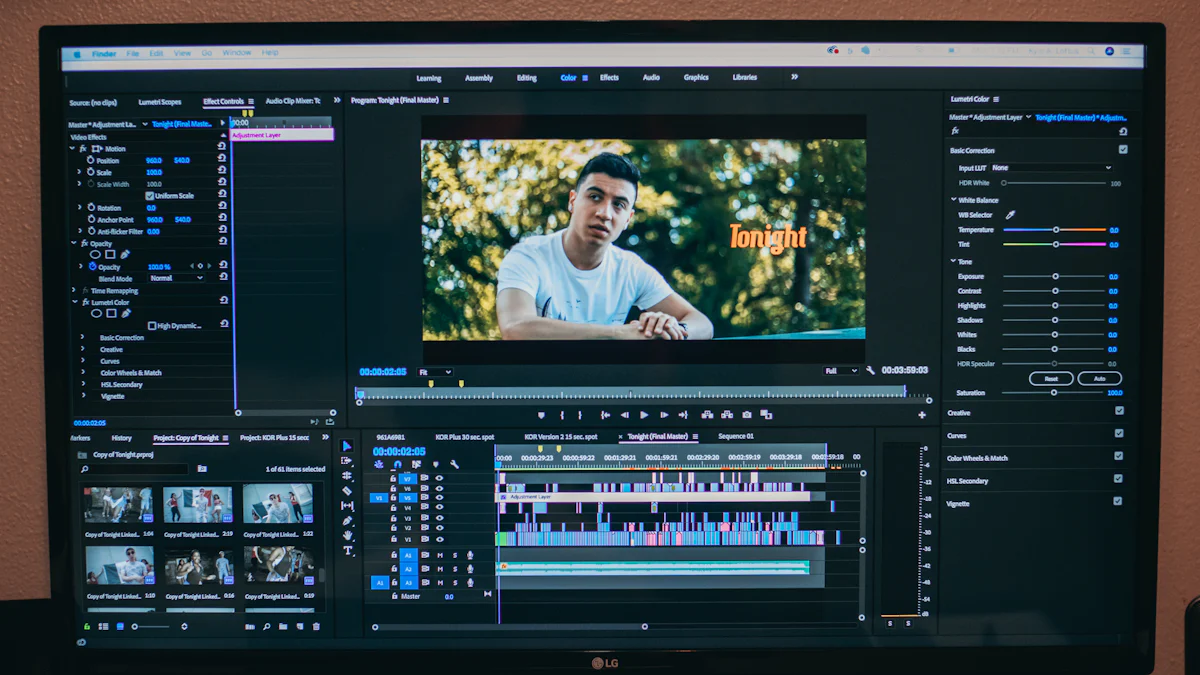how to record YouTube video

Are you ready to record YouTube videos like a pro? The surge in YouTube users engaging with creators highlights the significance of creating quality content. In this guide, we will explore the essential tools and methods for effective video recording. Whether you're a novice or an intermediate user, our aim is to empower you with the skills needed to produce captivating YouTube videos that resonate with your audience.
Understanding the Basics
What You Need to Get Started
Essential Equipment
High-quality camera: A comprehensive recording setup typically comprises a high-resolution camera, professional-grade microphones, studio lighting, and video editing software.
Professional microphone: Using high-quality equipment, such as a professional camera and microphone, can make a big difference in quality. So make sure to have these essentials ready before recording customer testimonial videos.
Software Requirements
Before you start recording your YouTube video, ensure that you have the necessary software installed on your device. This may include video editing software for post-production enhancements and audio editing tools for refining sound quality.
Setting Up Your Recording Space
Choosing the Right Location
To create engaging YouTube videos, select a quiet filming studio setup or a location with minimal background noise. This will help maintain focus on your content without distractions.
Steady tripod: When you have a space with good light, good sound quality, and a steady tripod, you don’t have to splurge as much on a high-end camera to capture quality video. That said, a camera is a must-have on any YouTuber essentials list, and there are options for every budget and skill.
Background and Props
Consider the visual appeal of your recording space by adding relevant props or backgrounds that complement your content theme.
Ensure proper lighting in your recording area to enhance the overall video quality and create a professional look for your YouTube channel.
Recording Your Video

Preparing Your Script and Content
Writing a Script
To create engaging YouTube videos, writing a script is essential for maintaining a structured flow of your content. A well-crafted script helps you stay on track, deliver key points effectively, and engage your audience throughout the video.
Start by outlining the main topics or key messages you want to convey in your video.
Organize your script into sections to ensure a logical progression of ideas.
Use bullet points or numbered lists to break down complex information into digestible segments.
Incorporate natural pauses or transitions to allow for smooth delivery and maintain viewer interest.
Planning Your Content
When planning your content for YouTube videos, consider the preferences and expectations of your target audience. Tailoring your content to meet their needs can significantly impact viewer engagement and retention.
Conduct research to identify trending topics or popular themes within your niche.
Brainstorm creative ways to present information or add value to existing discussions.
Consider incorporating storytelling elements or personal anecdotes to establish a connection with viewers.
Create a content calendar to schedule video releases and maintain consistency in your uploads.
Technical Steps to Record
Setting Up Your Equipment
Optimizing equipment setup plays a crucial role in ensuring high-quality recordings for your YouTube videos. Properly configuring your camera, microphone, and lighting can enhance the overall production value of your content.
Position the camera at eye level to establish direct eye contact with viewers.
Test audio levels before recording to prevent sound distortions or background noise interference.
Adjust lighting angles and intensity based on the desired mood or ambiance of your video.
Use external microphones for improved audio clarity and minimize echo effects in recordings.
Using Recording Software
Selecting the right recording software is vital for capturing and editing YouTube videos seamlessly. Understanding the features and functionalities of different software options can streamline your recording process and enhance post-production capabilities.
Experiment with various recording settings to determine the optimal resolution and frame rate for your videos.
Familiarize yourself with editing tools such as cutting, trimming, and adding effects to refine the visual appeal of your content.
Explore advanced features like green screen effects or filters to add creativity and uniqueness to your videos.
Regularly update software versions to access new features and ensure compatibility with evolving recording technologies.
Editing and Finalizing Your Video

Basic Editing Techniques
Cutting and Trimming
When it comes to video editing, precision is key. Cutting unnecessary segments and trimming excess footage can significantly enhance the overall quality of your content. By eliminating distractions and focusing on essential elements, you can create a more engaging viewing experience for your audience.
Start by reviewing your footage to identify sections that may need trimming or cutting.
Use editing software tools to remove any pauses, errors, or irrelevant content from your video.
Ensure smooth transitions between clips by precisely cutting and trimming each segment for coherence.
Experiment with different pacing techniques to maintain viewer interest throughout the video.
Adding Effects and Transitions
Enhancing your videos with effects and transitions can elevate the visual appeal and storytelling aspect of your content. Whether you're aiming for a professional look or a creative touch, incorporating these elements can make your videos more dynamic and captivating.
As Shoots Video suggests, "Transitions help smooth the visual flow between different clips."
Explore various transition options such as dissolves, fades, or wipes to create seamless connections between scenes.
Experiment with effects like color correction, filters, or overlays to enhance the mood or style of your video.
Adjust color tones and brightness levels to improve visual consistency across different clips.
Incorporate text overlays or graphics to emphasize key points or add context to your narrative.
Adding Audio and Music
Voiceovers and Narration
Audio quality is a crucial aspect of video production that should not be overlooked. Including voiceovers or narration in your videos can provide clarity, context, and engagement for your viewers. By delivering information through spoken words, you can enhance the overall storytelling experience.
According to Shoots Video, "Clear, high-quality audio is crucial for an engaging video."
Record voiceovers using a dedicated microphone to ensure crisp sound quality without background disturbances.
Practice proper enunciation and pacing when narrating scripts to maintain audience comprehension.
Adjust audio levels during post-production to balance voiceover volume with background music or sound effects.
Use audio editing tools to remove noise, enhance vocal clarity, and synchronize narration with video visuals seamlessly.
Background Music
Adding background music can evoke emotions, set the tone, and create a memorable atmosphere for your videos. The right soundtrack enhances viewer engagement and reinforces the message conveyed in your content. Selecting appropriate music that complements your narrative is essential for a cohesive viewing experience.
Choose royalty-free music tracks that align with the mood and theme of your video without infringing copyright laws.
Adjust music volume levels to ensure it enhances rather than distracts from the main audio elements.
Experiment with different genres or styles of music to find the perfect match for each video project.
Use fade-in/fade-out effects at the beginning and end of tracks for smooth transitions between audio segments.
Legal Considerations
Copyright and Fair Use
Using Copyrighted Material
When incorporating external content into your YouTube videos, it's essential to understand the guidelines surrounding copyrighted material. Utilizing copyrighted works without proper authorization can lead to potential legal issues. However, there are instances where you can use copyrighted material under specific circumstances.
Fair Use Policy on YouTube: This policy allows creators to use copyrighted material without permission under certain conditions. These conditions include commentary, research, teaching, news reporting, criticism, and more.
Fair Use Doctrine in the US: The Fair Use Doctrine aims to promote freedom of expression by permitting certain uses of copyrighted material. Factors considered include the purpose of use, nature of work, amount used, and market effect.
Remember that respecting copyright laws is crucial when incorporating third-party content into your videos. Always ensure that you have the necessary permissions or fall within the fair use guidelines to avoid copyright infringement.
Creative Commons and Royalty-Free Content
To enhance your video content legally and ethically, consider utilizing Creative Commons and royalty-free resources. These resources provide a wide range of multimedia assets that you can incorporate into your videos without worrying about copyright violations.
Fair Use Definition on YouTube: This legal doctrine permits the reuse of copyright-protected material under specific conditions without seeking explicit permission from the copyright holder.
By leveraging Creative Commons materials or royalty-free content, you can add depth and creativity to your videos while complying with intellectual property regulations.
Explore platforms that offer a variety of Creative Commons licenses or royalty-free assets for music, images, videos, and more. Remember to attribute the original creators when required and adhere to any licensing terms associated with the content you use in your videos.
As Shoots Video emphasizes, "Respecting copyright laws and utilizing Creative Commons resources can help you create engaging content while staying compliant with legal standards."
Recap the essential steps to create compelling YouTube videos. Practice is key to enhancing your recording skills and engaging with your audience effectively. Explore additional tips and resources for continuous learning and improvement. Take action now by starting to record and share your unique content on YouTube. Remember, the more video testimonials you create, the stronger social proof you'll have, showcasing the value of your offerings to potential customers.
See Also
Easy Guide to Applying Echo Effects to Audio Online
Mastering Test Sessions on Google Meet
Best 360 Camera Live Streaming Options for Social Media
Key Strategies for Hosting a Successful Video Conference
Optimizing Remote Meetings with Advanced Auto-Tracking Webcam

